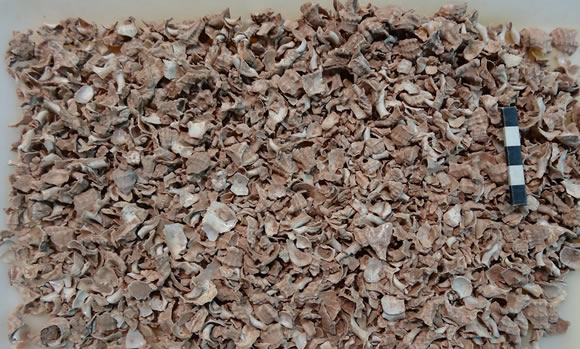Hexaplex trunculus. It sounds like a Harry Potter spell, although there’s nothing particularly magical about this species of sea snail common in the warm waters of the Mediterranean Sea. Still, these tiny purplish molluscs are an important piece of an enormous puzzle that’s been perplexing Carl Knappett for years.

Knappett is the co-director of the Palaikastro Project and the Walter Graham/Homer Thompson Chair in Aegean Prehistory in the Department of Art. He is studying the urbanization of Minoan Crete during the Aegean Bronze Age. Why did the Minoans choose to settle in some locations and not others? What impact did they have on the landscape? In what ways were local resources exploited and how did this change over time? “We can observe the process of urbanization through features like monumental architecture, planned streets and sewers, as well as changes in agriculture and the landscape,” says Knappett. This is where the Hexaplex trunculus comes in.
Knappett and his team of researchers, which includes specialists in botanical, faunal and marine remains, have been excavating at Palaikastro, the site of a Minoan harbour town on the island of Crete that dates back to 1700 BCE. Recently, they uncovered a deposit of more than 10,000 Hexaplex trunculus shells. In ancient times, they would have been used to create a purple-blue indigo dye. (The dye is even mentioned in the Hebrew bible.)
The shells were discovered a few feet below the surface, in what appears to have been a basement room used for processing. Creating the dye is complicated — Knappett even enlisted a couple of students to experiment with making the dye using shells given to them by local fishermen, which they then applied to linen, wool and silk — and it suggests that the Minoans were skilled at making fine textiles. “It also tells us that they were proficient in exploiting marine resources, and indeed we found various other kinds of shells used for consumption and even triton shells for some sort of religious activity,” says Knappett.
Knappett’s team has also discovered tiny carbonized fragments from olives, almonds, pulses and cereals, that, when combined with goat and sheep remains found at the site, paint a picture of agropastoral practices. “It’s not just what was exploited, but how — whether in small gardens or larger fields,” he says. “We’re keen to see if urbanization had any effect on these strategies, and if that led to land erosion and other environmental impacts.”
Near the beach at Palaikastro, Knappett is collecting palaeoenvironmental data by coring the wetland. He’s already drilled down 7.5 metres in the hope of uncovering carbon that can be dated, as well as pollen. “We’ll be able to say what trees and other plants were in the landscape at given dates thousands of years in the past,” he says.
But Knappett’s research doesn’t end at snail shells and almonds. Those items are just tiny clues to understanding the economic, social and political organization of the town and its surrounding hinterland.
“Given that it’s a coastal site, and for many centuries people here seem to favour the uplands, it begs the question: why did the Minoans decide to live here to begin with?” says Knappett. “Presumably the opportunities for trade and exchange through wider regional connectivities were too good to pass up, and the coast allowed for more ready contact with some distant parts of the island, and indeed with other islands, and even with the Near East and Egypt.”
It’s these kinds of connectivities that Knappett is exploring through his pioneering work in network analysis, which models the kinds of interactions that might have been beneficial to the inhabitants at the time.
“Profound socio-political change in ancient societies seems often to be generated by contact and exchange with other cultures, in many cases over long-distances,” he says. “Why does this happen? How are such connections established and then maintained? These are the big questions that we are trying to answer.”
And it all starts with understanding something as simple as the role of a sea snail.

